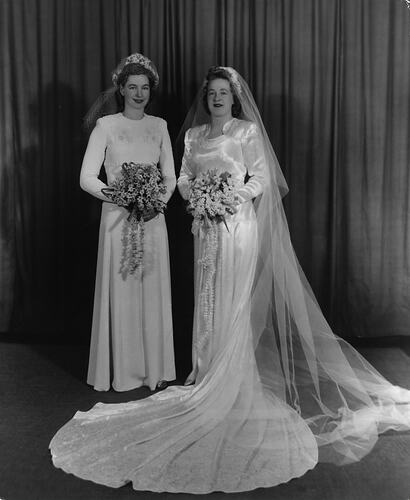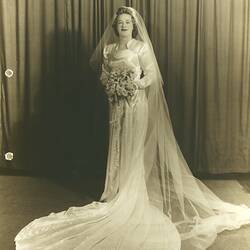Summary
Digital copy of an original photographic portrait of a bride and bridesmaid in studio: Elaine Smith and her sister Mina on the day of Elaine's wedding to Thomas Colbert, Melbourne, 1947. Elaine's wedding dress was also donated to Museum Victoria (HT 23948) as part of a larger collection.
Description of Content
Wedding photograph - bride and bridesmaid in studio Melbourne, 1947.
Significance
Statement of Significance:
One of several items documenting a post-war Melbourne wedding. The items encapsulate the events and traditions of the time: the dress was made from fabric purchased with coupons from Georges (war-time rationing of clothing was gazetted on 12 June 1942 and removed on 24 June 1948); it was made by the bride's mother's dressmaker; and it was designed by the bride, who had been frustrated in her desire to become a nurse by her father, and instead was studying architectural drafting at night school, and hence had good drawing skills. The dress is made of cream satin, a variation of the white wedding dress that was by then an established Western tradition. The bride's middle class status is reflected in the fact that she was able to have a dress made to wear only at her wedding, and not afterwards, as was often the case during war-time; and by her selection of the exclusive women's clothing shop Georges as the source of her fabric (she also bought her going-away dress there, ready-made). The generous quantity of fabric in her veil also highlights the value of the bridal outfit, as does the fact that she later sent the veil to England, to by worn by the sister-in-law of a naval officer, who was living in England in straitened circumstances.
The dress is accompanied by a simple charm in the shape of a shoe, given to the bride by her cousin, and worn over the bride's arm in the church - the Presbyterian Church, on the corner of New Street and North Road, Brighton. The charm reflects the remnants of folk practice. Popular tradition gives the shoe symbolic importance since Anglo-Saxon times, variously as a symbol of the transfer of 'ownership' of the bride from father to husband (father removing shoe from bride to give to husband), for tossing to members of the wedding party who hoped to marry, or for bestowing luck on the bridal couple (for instance, the 1902 Army and Navy Stores catalogue has 'midget' silver shoes inscribed 'GOOD LUCK', and white satin 'paper slippers' to contain confetti, ices or confestionery).
The bouquet carried by the bride was another important accessory, meaningful on several levels. The flowers were both decorative and symbolic, referring to the fertility of the union; and the fact that they came from her mother's garden provided a personal link back to family and her mother's role in that family.
The significance of this collection is further enhanced by the comprehensive story provided by the bride, who donated the dress and accessories. She tells of settlement on a poultry farm in Clayton obtained by her husband as an ex-serviceman, of their struggle to make a life there, and of their eventual decision to move to Mornington to raise their family, with her husband working as a public servant. The story also links to the story of her father, who kept meticulous account books documenting the expenditure of his family for over 40 years, also donated to Museum Victoria.
More Information
-
Collecting Areas
-
Acquisition Information
Donation from Mrs Elaine H. Colbert, 01 May 2008
-
Person Depicted
Mrs Elaine Colbert nee Smith, Greater Melbourne, Victoria, Australia, 1947
-
Format
Digital file, Black & White
-
Classification
-
Category
-
Discipline
-
Type of item
-
References
'Wartime Weddings! Fashions on the Front, Helen Catriona, 3 Mar 2019, [Link 1] accessed 29 Jun 2021.
-
Keywords
Domestic Life, Marriage Customs & Rites, Photographic Studios

